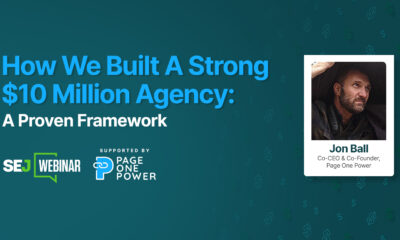MARKETING
The Best Story Framework for More Engaging Storytelling [Example]
![The Best Story Framework for More Engaging Storytelling [Example] The Best Story Framework for More Engaging Storytelling [Example]](https://articles.entireweb.com/wp-content/uploads/2022/09/The-Best-Story-Framework-for-More-Engaging-Storytelling-Example.jpegkeepProtocol.jpeg)
Even if you’re not a professional storyteller, you can use storytelling frameworks to share more engaging narratives in your content marketing copy. You’ll not only be able to tell your company’s story more effectively to stakeholders, but you’ll be able to write more effective, readable material that converts users into loyal customers.
Whether you’re writing for your website, blog, social media profiles, presentations, or online offers, the framework discussed below will help you gain confidence in storytelling and start telling better stories in business and in life. Let’s get started.
Why use a storytelling framework?
As content strategists, we should spend a lot of time thinking about the importance of storytelling in marketing, but we don’t — mainly because it’s so intimidating. The pressure-filled process of creating a framework and telling a story can keep a lot of people from even making an attempt. When the subject comes up, we understandably get nervous.
The thing is: storytelling is part of what makes us human. We don’t have to be Ernest Hemingway to be good at it. We can use a storytelling framework to guide us in the writing process.
Storytelling frameworks make our copy and content feel familiar to readers, while providing us with an easy “formula” to follow. The good news is that your content will never feel formulaic, because you can (and should) diversify how you write individual pages or posts. However, the bare bones stay the same.
Storytelling Template: The Hero’s Journey
The Hero’s Journey is a storytelling template from author Joseph Campbell, and it’s everywhere. It’s one of the most relatable storylines because it basically mirrors the journeys of our own lives. Understanding The Hero’s Journey can give you insight into how to frame your own stories, whether it’s the true story about your company or a fictional story that stirs your imagination.
The following diagram breaks down this Hero’s Journey template, step by step.
![The Best Story Framework for More Engaging Storytelling [Example] storytelling template: the heros journey](https://articles.entireweb.com/wp-content/uploads/2022/09/The-Best-Story-Framework-for-More-Engaging-Storytelling-Example.png)
Typically broken down into three acts, the Hero’s Journey goes as follows:
Act 1:
- Ordinary World: A character (either you or your customer) is living a regular life.
- Call to Adventure: The character becomes aware of a problem or a task that must be completed.
- Refusal (of call): The character initially shows refusal — think of a customer who refuses to switch from their current provider despite their pain points.
- Meeting with the Mentor: The character meets a person who’ll guide them in the process of completing the task — think of a sales person guiding a lead toward conversion.
Act 2:
- Crossing the Threshold (into new life/experiences): The character officially starts their journey of solving the task, like a customer who’s just made a new purchase.
- Tests, Allies, Enemies: The character faces different trials in the process of completing the task.
- Approach to Innermost Cave: The character approaches the final battle — think of a professional who must now get their entire team to adopt a solution.
- Ordeal: The character goes through a battle or showdown — like in-team disagreements or discussions with stakeholders.
- Reward: The character emerges triumphant.
Act 3:
- The Road Back: Typically, the challenge isn’t over, and the character must deal with “blowback” from their previous battle.
- Resurrection: The character emerges with a new power, internal lesson, or external change.
- Return with Elixir: The character returns home or moves forward into a new adventure.
This is the Hero’s Journey, which—modified in various ways—we see repeated in stories throughout history. We have an ordinary person (what is), and we have adventure that lies ahead (what could be). The transference from one to the other is the journey.
Another great story template comes from comedy writing. It starts similarly: A character is in a zone of comfort. But they want something, so they enter into an unfamiliar situation. They adapt, and eventually get what they’re looking for, but end up paying a heavy price for it. In the end, they return to their old situation, having changed.
The Hero’s Journey: Fiction Example
The greatest story ever told…
Yes, we’re talking about Star Wars. Let’s step through a crude synopsis to see how well it matches Campbell’s pattern:
- Ordinary World: In the first Star Wars film, we begin with the rather ordinary Luke Skywalker. He lives on a farm on a desert planet.
- Call to Adventure: One day, he meets some robots who need help. They need to find a local hermit named Obi-Wan Kenobi. Luke takes the robots to Obi-Wan, who basically says, “Luke, you need to go out and help save the universe.”
- Refusal of Call, Meeting with Mentor, & Crossing the Threshold: Luke initially says, “No, I have all this stuff going on,” but Kenobi, who becomes Luke’s mentor, convinces Luke that he should go. Kenobi trains him how to use a lightsaber, and Luke goes on an epic space adventure.
- Test, Allies, Enemies: On the journey, Luke meets the villain, Darth Vader. He battles evil stormtroopers. He makes friends: Han Solo, Chewbacca, Princess Leia.
- Approach to the Innermost Cave: Luke then has to help defeat the super-weapon, the Death Star.
- Ordeal: Nearly everything goes wrong, but in the end, Luke succeeds in blowing up the Death Star.
- Reward: The last scene of the movie is of Luke getting a metal put over his neck by the princess, who kisses him on the cheek.
- The Road Back, Resurrection, & Elixir: Now he is in his new home, a changed man, emboldened by the great power of the Force, which he can use on future adventures.
The Hero’s Journey: Business Example
In business, the Hero’s Journey can most apply to case studies. (Most of them are a little less entertaining stories than Star Wars, unfortunately.)
A case study is the story of where a customer was, where they wanted to be, and how they overcame that gap.
If you listen to podcasts, you’ll hear this story told in almost every ad. You’ll also see it in “About us” pages. For example, check out Harry’s:
“Our founders, Jeff and Andy, created Harry’s because they were tired of overpaying for overdesigned razors. Instead, they wanted simple, high-quality products that felt good to use, all at a fair price. When they asked around, they learned lots of guys were upset about the situation too, so they decided to do something about it.”
![The Best Story Framework for More Engaging Storytelling [Example] storytelling framework example: harrys](https://articles.entireweb.com/wp-content/uploads/2022/09/The-Best-Story-Framework-for-More-Engaging-Storytelling-Example.jpeg)
The problem with most brands’ stories is that they don’t walk us through enough of the steps of the Hero’s Journey to capture our attention.
That’s why these frameworks are so useful. They’re a really easy way to ensure that we’re more creative when we’re coming up with stories or trying to convey information. This framework helps you focus your creativity.
Need more? Check out The Storytelling Edge: How to Transform Your Business, Stop Screaming into the Void, and Make People Love You for more detail on using the Hero’s Journey in your business writing.
How to Bolster Your Storytelling Framework with the Benjamin Franklin Method
As you continue using storytelling templates, you can use Benjamin Franklin’s writing method to strengthen your skills and create better business stories.
What is Benjamin Franklin’s method, you ask?
Benjamin Franklin devised a system for mastering writing. He collected issues of a publication that contained some of the best writing of his day, and reverse engineered the prose. He took notes at a sentence level, sat on them for a while, and tried to recreate the sentences from his own head, without looking at the originals.
Upon comparison, Benjamin found that his vocabulary was lacking, and his prose was light on variety. Despite that, he did it over and over. Unlike the more passive method most writers use to improve their work (reading a lot), this exercise forced Franklin to pay attention to the tiny details that made the difference between decent writing and great writing.
Here’s how you can use this method to bolster your storytelling template.
Step 1: Reverse engineer your competitors’ copy.
Take a piece of copy that you particularly admire from your competitor’s website. It can be a webpage, a case study, a white paper, or an article. Read it while noting what’s particularly effective about it, then set it aside and rewrite it in the best way you know how. Be sure to use your notes to guide your rewrite, and try to identify the storytelling template your competitor is using.
Note: Don’t publish this material, as it can be flagged as plagiarism! But you’re welcome to keep it in a private doc.
Step 2: Compare your reworked version to the original.
Set the two versions side by side. How does yours compare? What is it missing? What did your competitor do well? How did you do well? Note your findings in a separate document. Do this again and again with your competitors and even your own copy. Once you have enough insight and experience, you can begin applying your findings to your new copy and even use it to rewrite your old copy.
A Storytelling Framework is Essential for Great Copy
By using storytelling frameworks, you’ll learn to write stronger business stories in no time. The Hero’s Journey is a best-in-class example for writing case studies, advertisements, articles, and even tutorials. Remember: People don’t remember brands. They remember stories. Use this to your advantage.
Note: This post contains excerpts from The Storytelling Edge: How to Transform Your Business, Stop Screaming Into the Void, and Make People Love You by Joe Lazauskas and Shane Snow.
Editor’s note: This post was originally published in January 2018 and has been updated for comprehensiveness.

![The Best Story Framework for More Engaging Storytelling [Example] Click here to download our free introductory ebook on marketing psychology.](https://articles.entireweb.com/wp-content/uploads/2022/07/1658858538_121_16-Common-Logical-Fallacies-and-How-to-Spot-Them.png)


















You must be logged in to post a comment Login